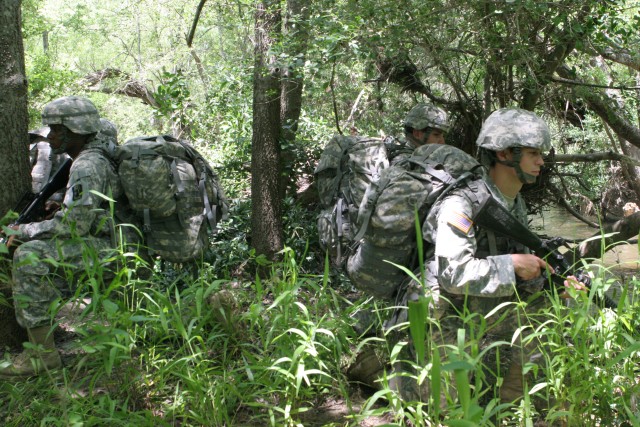FORT SAM HOUSTON, Texas -- Twelve Soldiers of the 470th Military Intelligence Brigade recently completed the first rugged phase of training at Camp Bullis to qualify for membership in a Low Level Voice Intercept team.
Normally operating on difficult terrain in demanding conditions, LLVI teams scan airwaves, homing in on radio, cell phone or other transmissions to gather information on enemy activity during combat operations.
Aca,!A"The order was simple,Aca,!A? said Sgt. 1st Class Ismael Padilla, lead trainer for the teams. Aca,!A"Prepare two four-Soldier LLVI teams for a one-year deployment Aca,!" all in about 90 days.Aca,!A?
Lt. Col. James Royse, 717th MI Battalion commander, noted that the unit had to train and certify teams whose members had not previously worked with each other and who were inexperienced or unfamiliar with the tasks required.
Training got under way on Lackland Air Force Base, where the brigadeAca,!a,,cs 717th MI Battalion is stationed, before moving to Camp Bullis. In addition to the two teams, the battalion began training four Soldiers as alternate LLVI team members.
Aca,!A"The plan was to train these Soldiers and get them ready for deployment without physically breaking them down in the process,Aca,!A? Padilla explained.
Aca,!A"Not an easy task with the time table given. However, with the support of the companiesAca,!a,,c first sergeants, a plan was proposed to do just that and minimize injuries that would surely come from the strenuous training ahead.Aca,!A?
The conditioning phase began the first day and continued until the end. Soldiers started their day at 5 a.m., pounding out four-mile ruck marches with 45 pounds on their backs.
As time passed, both distance and weight increased. Between marches they performed guerrilla drills, such as high and low crawls, firemenAca,!a,,cs carry, sprints and buddy drags.
Aca,!A"All of the exercises are combat related to prepare the Soldiers for the physical and mental stresses of war,Aca,!A? Padilla noted.
Eventually, to reduce the chances for injury, afternoon conditioning sessions changed from additional rucking to swimming. Sessions started at 4 p.m. and all Soldiers were instructed to swim a total of 1.2 kilometers.
Soldiers who could not swim used lifejackets. After a couple of weeks, those Soldiers learned to swim and completed all laps without aid.
Soldiers also trained in land navigation. The LLVI teams had to move to given grid coordinates and set up a signals intelligence site. At first teams did this with little weight in their rucksacks, but by day 21 they were moving with 85 pounds Aca,!" a more realistic approach to conditions overseas.
In addition to land navigation and forced marches, they were constantly being tested on first aid, tactical survival skills and other field craft.
At the end of the first 30 days Soldiers completed a week-long field training exercise for evaluation, supporting a cavalry regiment in two force reconnaissance missions into the fictional country of Turakistan.
An Opposing Force, simulating enemy combatants, ensured that the LLVI teams were on alert by executing mock attacks in ambush.
Aca,!A"I am excited about this opportunity for Soldiers in our strategic battalion to deploy in this tactical role Aca,!" which units like ours do not normally perform,Aca,!A? said Royse.
Aca,!A"The field training exercise provided the battalion a measure of where to focus their next training efforts,Aca,!A? Padilla explained. Aca,!A"These Soldiers did very well.Aca,!A?


Social Sharing